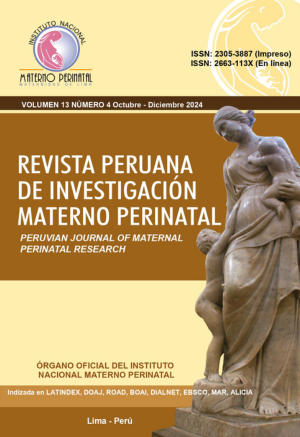Prevalence and characteristics of vertical transmission of the human immunodeficiency virus during pregnancy
##plugins.themes.bootstrap3.article.main##
Abstract
Objective: To determine the prevalence and characteristics of vertical transmission of the human immunodeficiency virus (HIV) in a referral hospital in Peru. Methods: A quantitative, cross-sectional, and descriptive study was conducted at the National Maternal Perinatal Institute between 2017 and 2023. HIV-screened pregnant women were included, analyzing maternal variables, delivery type, and newborn condition. HIV detection was performed using a rapid test, and data were collected from clinical records. Descriptive statistics were used for data analysis. Results: A total of 108 585 pregnant women were screened, identifying 357 HIV-positive cases (0.33%). Ten cases of vertical transmission (2.8%) were diagnosed, mostly intrapartum (60%). Cesarean delivery was observed in 90% of cases. Conclusion: Maternal HIV seroprevalence was 0.33%, and vertical transmission prevalence was 2.8%. The findings highlight the need to improve early screening and optimize preventive strategies during pregnancy and the postpartum period.
Downloads
##plugins.themes.bootstrap3.article.details##
How to Cite

This work is licensed under a Creative Commons Attribution 4.0 International License.

